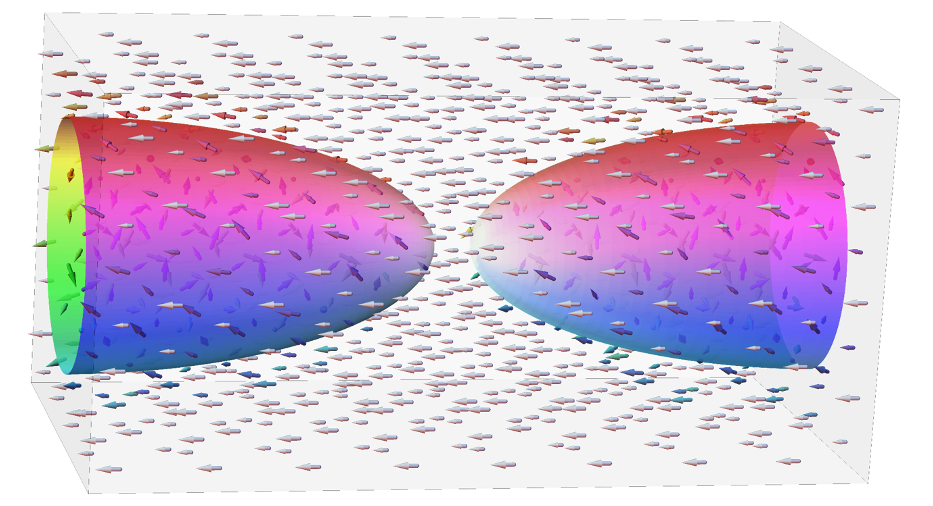All-electron DFT simulations of particle-like magnetic objects
Principal investigator: Dr. Daniel Wortmann
Project manager/Main researcher: Dr. Uliana Alekseeva
Researchers: Dr. Daniel Wortmann, Dr. Uliana Alekseeva
Title of research project: All-electron DFT simulations of particle-like magnetic objects
Funding: EU (H2020-INFRAEDI-2018-1 project GA 824143)
Project partners:Forschungszentrum Jülich, IT Center RWTH
Project endurance: dez 2021 – nov 2022
Project area: Solid state physics
Cluster: CLAIX2018
Software: FLEUR

Introduction:
Complex magnetic textures and particle-like structures such as chiral magnetic skyrmions with non-trivial topological properties are nowadays the most studied objects in the field of nano-magnetism. They offer the promise of new data storage and data processing technologies ranging from racetrack memories to memristive switches for neuromorphic computing. The theoretical and computational description of nanosized magnetic objects usually follows a typical multiscale approach: first, ab-initio simulations mostly based on Density Functional Theory (DFT) are utilized to determine fundamental materials properties. Then, based on the parameterized materials properties simpler purely magnetic models like the extended Heisenberg model are constructed and spin-dynamics simulations are employed to describe the final complex magnetic structures. While this approach has demonstrated its power and efficiency, it cannot describe fundamental changes in the electronic structure induced by the complex alignment of magnetic moments.
In this project we propose to extend the realm of DFT calculations for magnetic systems to significantly larger setups to tackle these challenges from the basic description provided by our ab-initio code FLEUR [1]. Our results will provide guidelines for the validity limits of the multiscale approach and explore the details of the electronic properties found in non-trivial topological magnetic structures.
Methods:
Our calculations are based on the all-electron full-potential linearized augmented plane wave (FLAPW) method. While the FLAPW method is a numerically complex and computationally heavy approach, it is also considered to provide the” gold standard” and reference results in DFT. Its accuracy and reliability proven in numerous applications is particularly crucial in the field of magnetism as the fundamental energy scales on which magnetic phenomena occur is usually very small. While DFT simulations of large setups containing many atoms are already possible for quite some time, the simulations we pursue extend the limits of so called all-electron DFT applied to large magnetic configurations.
A DFT simulation is an iterative process with 50-120 cycles to achieve a self-consistent solution of the fundamental quantum mechanical equations. A single of these self-consistency iterations contains many different steps like the determination of the potential, the generation of a new density and the density mixing to accelerate the self-consistency process. From the computational point of view, the most relevant task in each iteration consists of the setup of matrices for the generalized eigenvalue problem and its diagonalization. The hybrid MPI/OpenMP parallelization of the FLEUR code allows to efficiently utilize clusters like CLAIX2018 [2].
Results:
To get insight into the details of the electronic structure which are not in reach of conventional multiscale approaches, we performed simulations with two arts of magnetic setups: i) a globule with two Bloch points in the MnGe super cell and ii) a skyrmion in a HBi film. Our largest system which contains a Bloch Point has 1600 atoms. The dense Hermitian matrices to store the Hamiltonian and overlap operators are of the size 230k x 230k elements and need at least 820 GB memory each. The computational cost to converge such a non-collinear magnetic setup including spin-orbit interaction is about 1.5 million core-hours.
Discussion:
In continuous models, a Bloch point manifests itself as a singularity at which the magnetization vanishes. This already indicates that drastic changes in the electronic structure can be expected. When a system with a Bloch point is simulated with spin-dynamic methods, only the directions of the magnetization vectors are allowed to relax. Our simulations show that the magnetization of the atom most close to the Bloch point is significantly reduced in value and that there is no singularity-like Bloch point in the continuous magnetization field but rather a “Bloch-landscape” with a complicated profile.
Outlook:
It has been shown [3] that hydrogenated Bi monolayers can exhibit large topological bandgaps and manifest a quantum spin Hall effect. As the partially hydrogenated Bi monolayer is magnetic, the effect of magnetic order on the electronic structure can be significant. In particular the complex interplay between the topological protection in the quantum anomalous state and the magnetic order introduces a rich playground in which details of the electronic structure can be controlled and manipulated by the arrangement of magnetic moments in the system. While such effects have been simulated by means of simple tight-binding models, these models can only indicate the basic phenomenon but fail to grasp the details. We therefore plan to study large unit-cells with non-trivial magnetic order imposed.
References:
[2] U. Alekseeva, G. Michalicek, D. Wortmann and S. Blügel, “Hybrid Parallelization and Performance Optimization of the FLEUR Code: New Possibilities for All-Electron Density Functional Theory”, in: Springer International Publishing AG, part of Springer Nature 2018 M. Aldinucci et al. (Eds.): Euro-Par 2018, LNCS 11014, pp. 735–748, 2018.
[3] C.Niu, G.Bihlmayer, H.Zhang, D.Wortmann,S.Blügel and Y.Mokrousov, “Functionalized bismuth films: Giant gap quantum spin Hall and valley-polarized quantum anomalous Hall states”, Phys.Rew. B 91, 041303 (2015)